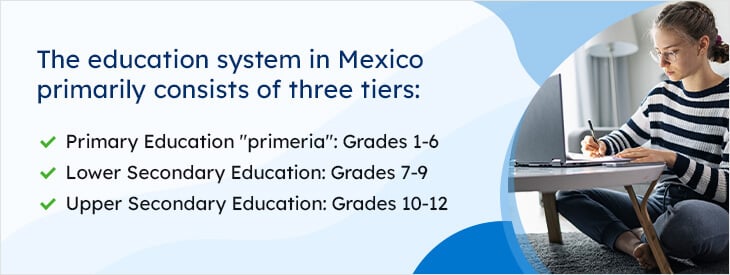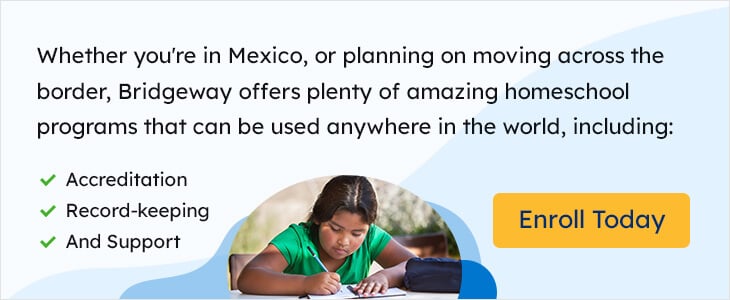Just like any other type of schooling, homeschooling is an international endeavor. Millions of families around the world have made the decision to take their child’s education into their own hands, especially during and in the wake of COVID-19. And, like the United States, every country has its own opinions, philosophies, and laws surrounding homeschooling.
In this monthly series, we’ll take a look at different countries around the world and how they view homeschooling as well as the types of laws (if any) those countries have to govern homeschooling. The first country we visited was the second-largest country in the world, and the northern neighbor to the United States–Canada. Then we went island hopping to the Philippines and Puerto Rico before cruising on over to South Africa. We headed back to the Caribbean to the Dominican Republic, traveled all the way to Thailand, and now we make our way back west to check out homeschooling in Mexico!
Southern neighbor to the United States, the country of Mexico is home to nearly 130 million citizens, ranking number 10 among the world’s countries by population. Amazingly, Mexico is home to 17 cities that boast a population of more than 1 million people–the largest among them is Mexico City, with a population of over 22.5 million. The country is more than 761,000 square miles in size, making it the 13th largest in the world, and it’s also one of the fastest-developing countries in the world, with more and more people moving away from rural areas and into its cities.
Rules and Requirements for Homeschooling in Mexico
According to the Home School Legal Defense Association (HSLDA), Mexican families are free to homeschool without much, if any, interference from the government. Without any clear compulsory attendance laws, homeschooling in Mexico continues to thrive and grow–all legally.
Also, per the HSLDA, the Mexican constitution states that it is an obligation of every Mexican citizen to have their children to attend either public or private institutions in order to receive proper education. The obligation of parents to have preschool, primary, and secondary education is further stated in Article 4 of the General Law of Education.
Though homeschooling is a legal option in Mexico, there are some guidelines to follow in order to receive homeschool accreditation by Mexico. One way is to register with an accredited homeschool platform (like Bridgeway!) or umbrella school, which helps parents satisfy state requirements by providing transcripts and a diploma. If you have documents that prove your residency in the United States and are choosing a homeschool or umbrella school platform based in the States, be sure to check the homeschooling laws of that particular state to make sure you would be able to meet them from Mexico.
If your child was born in Mexico, you will need to provide the Mexican birth certificate of the student; for dual citizenship, you’ll have to register your child at the local civil registry. From there, it’s a good idea to set up an appointment with your SEP state representative and determine the cost of accreditation.
If you’re considering homeschooling in Mexico, you’re certainly not alone in your journey. Below is a list of homeschooling groups in Mexico that can help provide support and answers to your questions. Our Bridgeway families homeschooling in Mexico also have created their own homeschooling group on Facebook!
Homeschool Mexico – English Speakers Facebook
Mexico’s School System
The education system in Mexico primarily consists of three tiers:
- Primary Education: Mexico’s primary education (or “primeria”) begins in grade 1 and ends in grade 6, covering students ages 6 to 12; there is also a mandatory one-year preschool education requirement. The Secretariat of Public Education (SEP) uses standardized curriculum for Mexican public and private schools–subjects include math, Spanish, natural sciences, geography, history, art, and physical education.
- Lower Secondary Education: This tier covers grades 7 through 9 and is compulsory for Mexican children. Students can follow one of two tracks: academic or technical. Those in the academic track usually continue their education in the upper secondary level, while students in the technical track generally give up formal education after 9th grade and pursue non-academic programs, including vocational, commercial, and artistic training.
- Upper Secondary Education: Finally, the “preparatoria” (upper secondary education) level consists of grades 10 through 12. Many of these schools are affiliated with public universities, while some are run by the SEP, state, private schools, or prep schools. This tier’s two tracks include academic university and professional technical education. The Academic track provides students with a general academic curriculum for the first two years of study, followed by more specialized study in the final year. Foreign Language is compulsory and students are awarded the Bachillerato certificate and certifocado de estudios (transcript) upon completion. The General Baccalaureate system is administered by the Secretariat for Tertiary Education and Scientific Research (SESIC). In the professional track, Professional Technical Institutions provide technical preparation that prepares students to work immediately following completion. The track leads to the Título de técnico professional (Title of professional technician), and consists of general education classes and professional classes in their chosen field.
Though Mexico’s education system, on its surface, seems to be well structured, there’s still some work to be done.
U.S. News & World Report had Mexico ranked number 40 in education out of 87 countries in 2021. However, the Mexican government has made education a top priority and has recently made several changes that are expected to vastly improve the current system. According to the OECD iLibrary:
- Since 2013, the country has invested to increase enrollment rates in early childhood education and care and upper secondary education in order to support the most disadvantaged students financially. There has also been an effort to enhance educational infrastructure.
- Mexico introduced a new curriculum for compulsory education (from preschool through upper secondary education) focused on ensuring that all students develop the knowledge, attitudes, and skills required in the 21st century, including social-emotional skills.
- La Escuela al Centro and the Teacher Professional Service (Servicio Profesional Docente), including the school improvement support services (Servicio de Asistencia Técnica a la Escuela, SATE) are two fundamental structures that aim to transform schools’ structures while providing the tools for teachers to identify their needs and progress in their careers.
- Mexico has made significant progress in creating and running a comprehensive national system for education evaluation. This evaluation system was created to support quality and equity in education as mandated by the Mexican constitution.
- Plus, since 2003, PISA scores in mathematics have also improved among boys and girls by 30 and 26 points respectively.
There is still a long way to go, however, to get Mexico into more elite territory when it comes to education. More than 1 million students can’t afford the transportation or supplies required for school. Also, the country’s less-developed southern states are generally neglected by the government, which results in education participation and attainment rates 10 times lower than Mexico City. And while higher education enrollments have more than doubled between 2000 and 2017, Mexico still lags far behind other Latin American countries, according to UNESCO data.
Bridgeway in Mexico
Bridgeway Academy is the homeschool choice for more than 50 students in Mexico. While the country continues to make reforms and progress with its education system, many families (especially expats) do not want to wait around for change. After all, children only get one shot at education, and many parents–not just in Mexico, but around the world–have decided to take charge of their child’s learning by homeschooling.
If you’re currently living in Mexico or are planning on moving across the border, remember that Bridgeway offers plenty of amazing homeschool programs–plus accreditation, record-keeping, and support–that can be used anywhere in the world! Bridgeway is here to help your family choose the right program to fit your needs. You can download our free PDF about homeschooling with a U.S. based program.
Stay tuned to our blog–we’ll be bringing you homeschooling info from another international location soon!











